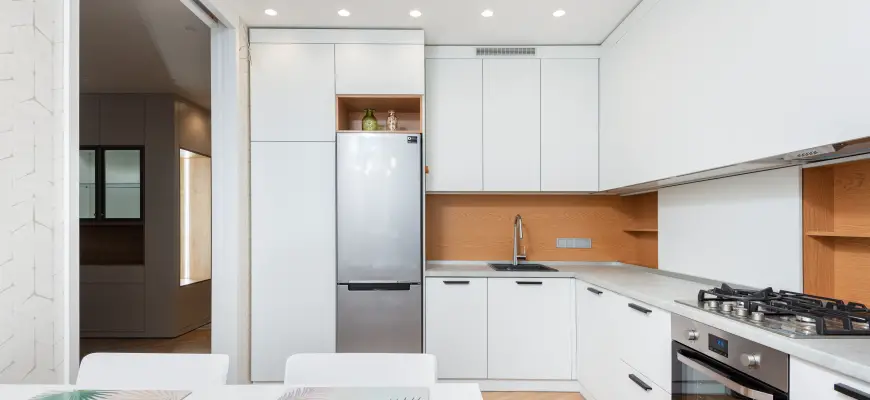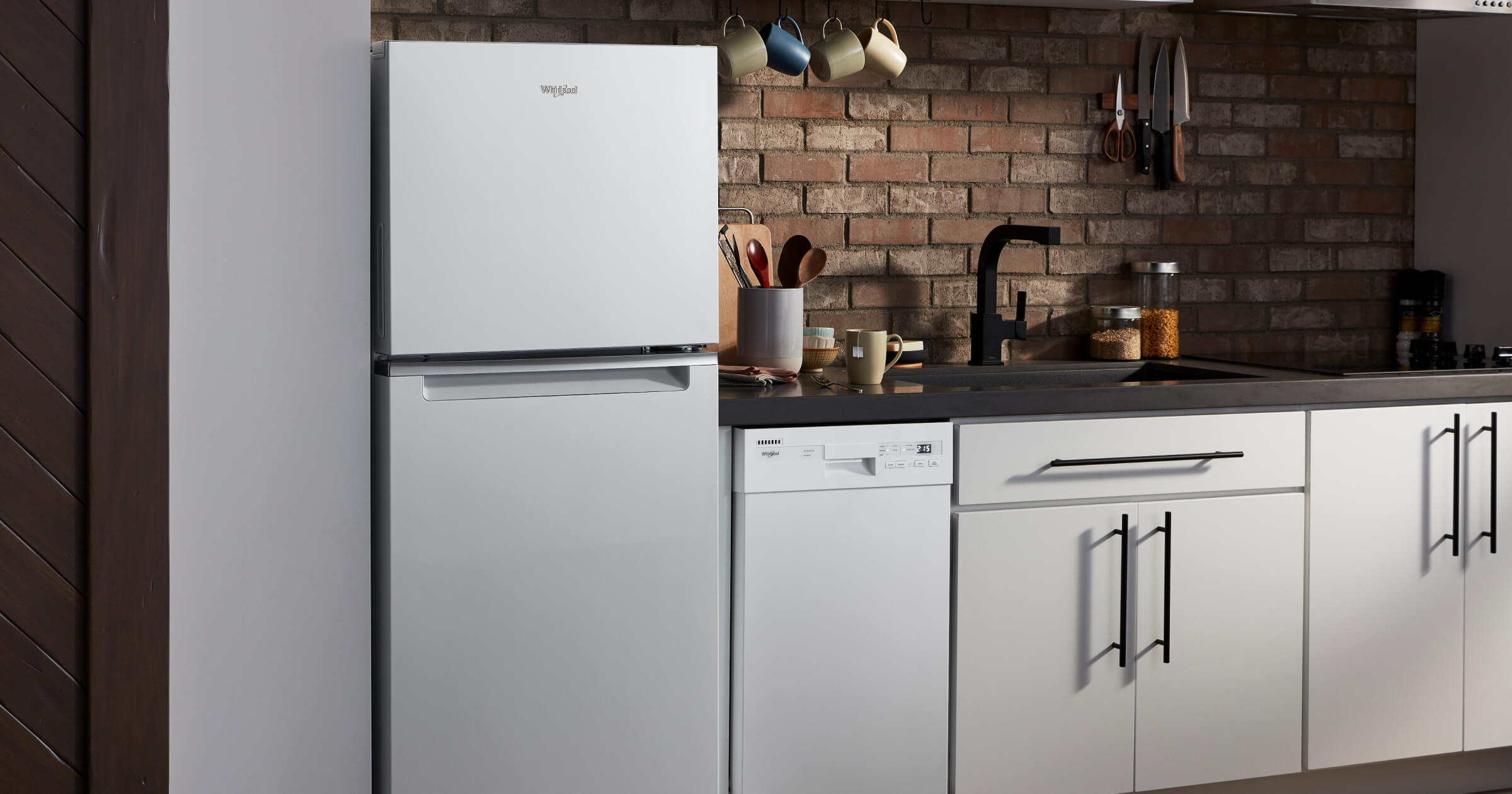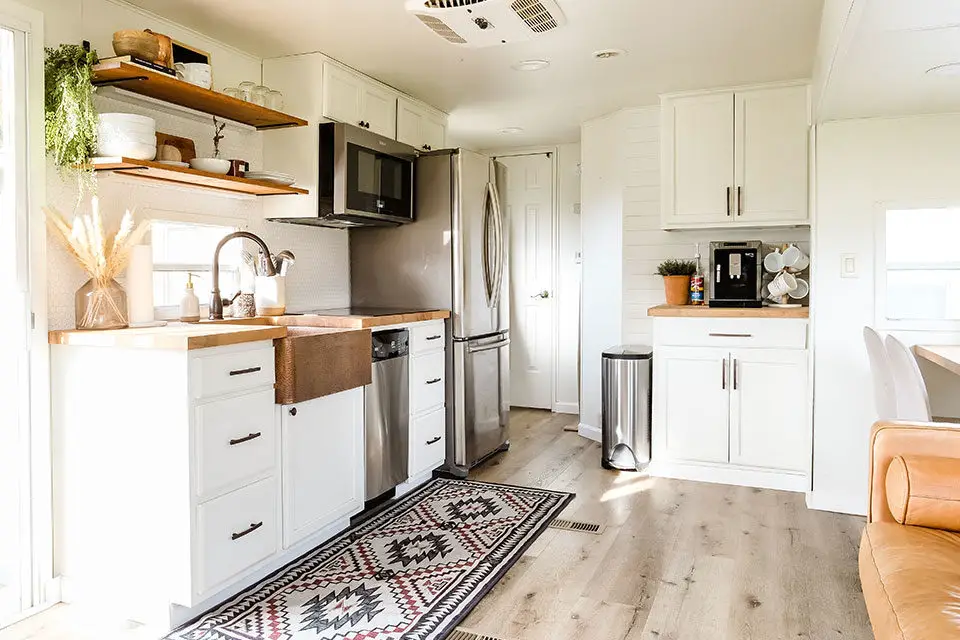When you’re dealing with a small kitchen, the last thing you want is to feel cramped. And one of the biggest space suckers in any kitchen is the refrigerator. This device is essential for keeping food fresh and safe, so you need to find a way to make it fit your kitchen. So, what can you do if your kitchen doesn’t have a lot of extra room for a fridge? Don’t worry – this article has got some ideas for you! It will discuss some creative ways to fit a fridge into a small kitchen.
Small Kitchen: What should be there?

A lot of people have to make do with small kitchens; in fact, many urban apartments nowadays have the smallest of kitchen spaces. To maximize the use of a small kitchen, it is important to consider what type of items should be present.
A small kitchen can contain essential items such as a sink, oven, and hob, fridge, countertop space for food preparation and storage. It means that if you have a small kitchen, it is important to consider which items should take priority and where they should be placed. For example, the hob should be placed close to the source of ventilation, such as a window or an extractor fan, while the fridge should be placed in an area that is both accessible and convenient [1].
What are the usual places to put a Refrigerator in the kitchen?
In many kitchens, the refrigerator is placed against a wall near an entryway. This is often the most convenient location because it allows you to easily access food items and other groceries when coming into or leaving the kitchen. There are some common places to put a refrigerator in your kitchen:
- Against an exterior wall
- Near a doorway or entryway
- In the corner of the kitchen
- Against an interior wall
These places are all popular options for putting a refrigerator in the kitchen. They allow you to easily access food and groceries while still making the most of your kitchen space. However, they may not be the best choice if you have limited space.
Ways To Put Fridge In Small Kitchen

One of the biggest considerations when it comes to fitting a fridge into a small kitchen is where to place it. The ideal spot for the fridge would generally be close to where food preparation takes place, as this will make food preparation easier and more efficient. However, this is not always possible due to space constraints. Fortunately, there are some creative ways to fit a fridge into a small kitchen.
Locate a location where the refrigerator doors will easily open
The best place to put a refrigerator in a small kitchen is somewhere that it will be accessible and easily opened. Look for places where the door can open without blocking traffic or narrow pathways. If there isn’t enough room to have an open fridge, consider having the doors pull out from one side instead of both sides.
Create Space
If you find yourself with limited space, get creative and make some extra space for your fridge. Consider creating a ‘fridge nook’ by removing any unnecessary furniture or apparatus from the area or even building a custom cabinetry unit around the refrigerator. This not only provides more space but also helps to keep refrigerators safer in a smaller kitchen by providing extra stability due to its built-in cabinetry.
Protect your device from direct sunlight
Direct sunlight can cause a refrigerator to overheat, so make sure to keep it in a position that is not affected by any windows or other sources of direct sunlight. If possible, install curtains or blinds for extra protection and insulation against the sun’s rays.
Install a built-in refrigerator
If your small kitchen can accommodate a built-in refrigerator, this is an excellent option for creating more space. Built-in refrigerators are installed into the cabinetry and blend seamlessly with their surroundings. This requires professional installation and will likely be a more expensive option than simply buying a freestanding fridge, but it is worth considering if you have limited space.
Below or above-counter placement

If none of the above options are suitable, consider placing your fridge either below or above counter-level. This will allow you to make full use of the limited space and keep the refrigerator in a position that is accessible yet tucked away out of sight.
Proper oven distance
Regardless of where you decide to place your fridge in a small kitchen, make sure to keep it at least one foot away from your oven. This will ensure that the heat generated by the oven does not affect the temperature inside your refrigerator and cause any potential damage. That is why it’s important to consider your oven placement before installing a refrigerator in a small kitchen.
Stay away from the hob
It’s also important to keep your fridge away from the hob or stove, as this could negatively affect its performance. A good rule of thumb is to ensure that there is at least a two-foot distance between these appliances. Keeping them apart will also help reduce any risk of fire in the kitchen.
Construct shelves
Another great way to make use of limited space in a small kitchen is to install shelves above or below the refrigerator. This will provide extra storage for items that you might have had difficulty fitting into your fridge and also help to keep the area tidy. On average, the dimensions of the shelves should be around 19,6 inches wide and 11,8 inches deep.
Do not forget about the corners
Finally, do not forget about the corners of a small kitchen. These can be great spaces for fitting in a refrigerator or even other appliances like microwaves and toasters. For example, an L-shaped countertop could be the perfect spot for your fridge. Additionally, the corners can also be used for setting up extra shelving or storage.
Use a Kitchen Island Instead of a Table
If you don’t have a lot of space in your kitchen, consider using a kitchen island instead of a table. This will give you more space to install your refrigerator and other appliances. Additionally, it can also serve as a food preparation or eating area for the family.
Use Folding Chairs and Tables
If you don’t have enough space to fit a kitchen island, consider using folding chairs and tables. These are great for creating extra seating and dining areas when you need them, but can be easily stored away when not in use. This is an excellent way to make full use of your limited kitchen space.
Install a Bar Fridge Instead of a Regular Fridge
With a little bit of creativity and effort, you can make the most out of any available space in your small kitchen. By following these tips, you will be able to successfully fit a refrigerator into a small kitchen and make the best use of your limited space. The key is to stay creative and look for creative solutions that will work for your specific needs when it comes to positioning appliances in a small kitchen.
How to make a small kitchen look larger?

One of the biggest challenges of having a small kitchen is finding enough space for all the necessary appliances. With limited countertop and cabinet space, it can be difficult to fit in items like a fridge. However, there are several creative ways to make your tiny kitchen look larger and accommodate a fridge. Here are some ideas to help you get started:
Move Your Fridge Up to Make Room for Cabinets: If you have particularly low ceilings in your kitchen, consider moving your refrigerator up higher on the wall. This will give you more space below for extra cabinets or shelves that can store everything from pots and pans to dishes and other items. However, this isn’t always possible if you already have upper cabinets in place.
Utilize Narrow Spaces: When space is tight, it’s time to get creative! Look for any nooks and crannies that might be able to accommodate your fridge. Also, don’t forget about the sides of cabinets or closets—they can often fit a skinny refrigerator if you’re willing to make slight modifications.
Try Counter-Depth Refrigerators: A counter-depth refrigerator is much shallower than a standard model, which means it won’t stick out as far from your cabinet line and take up valuable floor space in your kitchen. This type of fridge comes in many sizes, so you should be able to find one that fits perfectly in your kitchen.
Look for Refrigerators with a Top Freezer: A top-freezer refrigerator is a great option if you’re short on space since it takes up less room than a side-by-side model or French door version. The freezer section is at the top, so the fridge unit will fit comfortably below countertop level and won’t stick out too far into an already cramped kitchen.
Invest in Under Counter Refrigeration: If you don’t have enough space to accommodate a full-size fridge, consider investing in under counter refrigeration. This type of appliance usually comes in narrow widths and fits snugly between two base cabinets, giving you plenty of room to store groceries and other items.
How to choose the fridge for a small kitchen?
When you have a small kitchen, it can be difficult to fit a fridge in without compromising on style or space. Here are some tips for making sure your fridge is the perfect size for your home:
- Measure Your Space: Before starting your search for the right fridge, measure the area where you plan to place it in order to determine what size and shape will best fit the spot.
- Consider Fridge Dimensions: Fridges come in a variety of shapes and sizes, so it’s important to find one that fits your available space. Pay attention to height, width, and depth when narrowing down your choices. The fridge dimensions for a small kitchen can be as small as 17,7 inches x 17,7 inches, so be sure to check the sizing before making a purchase.
- Think Outside the Box: If you don’t have room for a traditional side-by-side refrigerator/freezer combo, consider other styles such as a French door or bottom-freezer model.
- Take Back-Splash Into Account: When shopping for a fridge, make sure to take into account the height of your countertop’s back-splash, so that you can be sure the fridge’s doors won’t hit it when opened.
- Opt for Compact Models: If you have an especially tight space, look for smaller, more compact models that are designed specifically for small kitchen spaces [3].
Comparison of Methods for Placing a Fridge in a Small Kitchen
When it comes to small kitchen layouts, finding the right spot for a fridge can be challenging. It’s crucial to consider practicality, functionality, and space optimization. In this table, we compare various methods for placing a fridge in a small kitchen, highlighting their advantages and disadvantages. The measurements are provided in the imperial system for convenience.
The table below provides an overview of four common methods for placing a fridge in a small kitchen. The methods compared include:
- Freestanding Placement: Placing the fridge as a standalone unit.
- Under-Counter Placement: Installing the fridge under a counter or cabinet.
- Side-by-Side Placement: Placing the fridge next to another appliance or cabinet.
- Built-in Placement: Integrating the fridge into the kitchen cabinetry.
| Method | Advantages | Disadvantages |
|---|---|---|
| Freestanding Placement | Flexibility to move the fridge as needed | Occupies valuable floor space |
| Under-Counter Placement | Saves floor space | May have limited storage capacity |
| Side-by-Side Placement | Maximizes vertical space | Requires adequate clearance for door opening |
| Built-in Placement | Seamless integration with kitchen design | Higher cost for custom cabinetry |
This table provides a quick overview of the advantages and disadvantages associated with each method. Consider these factors along with your specific kitchen layout and personal preferences to make an informed decision about where to put your fridge in a small kitchen.
FAQ
Where should my fridge be if my kitchen is small?
When it comes to fitting your fridge into a small kitchen, creativity is key. Depending on the size and layout of your kitchen, you could consider mounting the fridge onto the wall or creating recessed shelving around it. If space allows, try pushing your fridge up against a wall in an open corner, where you can still have easy access to it.
You could also get creative with light fixtures and other furniture to help camouflage certain aspects of the fridge or create visual depth in small spaces. For example, an open-shelved cupboard above the fridge can add extra storage without making the room feel cluttered.
Can a refrigerator be placed in a corner?
Yes, you can place a refrigerator in a corner. Make sure it’s away from sources of heat like radiators and windows to ensure optimal cooling. If possible, leave some breathing room around the fridge to help with ventilation. You could also utilize the space by creating shelves or cupboards above and below the fridge for extra storage.
Is it bad to put a refrigerator next to the stove?
No, but you should factor in proper ventilation when deciding on where to place your refrigerator in relation to the stove. Too much heat near your fridge could cause condensation which can lead to rusting or even electrical damage. In addition, keep flammable materials away from any open flames as this can be a potential fire hazard.
How close can you put a fridge to the wall?
As a general rule of thumb, you should leave at least 4 inches between your fridge and walls. This will ensure optimal airflow and prevent any damage to the wall or refrigerator. However, if you’re looking for a more creative option you can always wall-mount or recess the fridge into the wall creating a built-in look.
How much space do you need around a refrigerator?
You need at least 4 inches of clearance around the sides, back, and top of your refrigerator. This will provide enough space for ventilation and also make it easier to clean behind or around the fridge. If you’re considering wall-mounting or recessing your fridge, check with a professional to ensure that the structure can safely support the weight of it.
What is the minimum distance between fridge and stove?
The minimum distance between a fridge and stove should be at least 35 inches. This will ensure that heat from the stove does not affect the cooling or functioning of your refrigerator. Additionally, it’s important to keep any flammable materials away from open flames to avoid creating a potential fire hazard.
Can you put two refrigerators in the same kitchen?
Yes, you can put two refrigerators in the same kitchen as long as there is enough space and they are placed at least 39 inches apart. The additional fridge could be used for extra storage or food preparation if space allows. Make sure to factor in proper ventilation and soundproofing when deciding on where to place both fridges to avoid any noise interference with other appliances.
Where can I place a fridge in a small kitchen without taking up too much space?
In a small kitchen, it is important to maximize the available space. Consider the following options:
- Under the counter: If you have enough space, placing the fridge under the counter can help save valuable floor space.
- Wall niche: Look for unused wall niches or recessed areas where you can install a built-in or compact fridge.
- Cabinet space: Consider incorporating the fridge into your cabinet layout by choosing a refrigerator with a panel-ready design.
- End of a countertop: If there’s a narrow space at the end of a countertop, it can be a suitable spot for placing a small fridge.
How can I make my fridge blend in with the overall design of my small kitchen?
If you want your fridge to seamlessly integrate into your small kitchen’s design, consider the following tips:
- Choose a compact or panel-ready fridge: These types of refrigerators are designed to blend in with your cabinetry, giving a cohesive look to the kitchen.
- Opt for a color that matches your cabinets: If you can’t find a panel-ready fridge, select a refrigerator color that complements your kitchen’s color scheme.
- Use decorative magnets or vinyl wraps: To further camouflage the fridge, you can use decorative magnets or vinyl wraps that match the overall aesthetic of your kitchen.
- Position it behind a folding or sliding door: If feasible, you can hide the fridge behind a folding or sliding door when it’s not in use, creating a streamlined look.
How can I optimize the storage space inside my small kitchen fridge?
When dealing with limited space inside your small kitchen fridge, try the following strategies:
- Maximize vertical space: Use stackable containers, adjustable shelves, or fridge organizers to utilize the height of your fridge effectively.
- Utilize the door compartments: Take advantage of the door compartments to store condiments, jars, and other small items, freeing up space on the main shelves.
- Properly organize food items: Group similar items together and use clear storage containers to easily identify and stack food items efficiently.
- Regularly check for expired items: Periodically check the contents of your fridge and remove any expired or spoiled food to create more space.
What are some alternative locations for a small kitchen fridge if there’s no available floor space?
If you have a small kitchen with limited floor space, consider these alternative locations for your fridge:
- Wall-mounted fridge: Look for wall-mounted refrigerators that can be installed at eye level or higher, saving valuable floor space.
- Fridge drawer: Explore the option of installing a refrigerator drawer under the counter or in a kitchen island, utilizing underutilized space.
- Portable fridge: Consider using a compact portable fridge that can be placed on a countertop, table, or any other available surface.
- Appliance garage: Create a designated space in your kitchen cabinetry where the fridge can be tucked away when not in use, similar to an appliance garage.
What are the safety considerations when placing a fridge in a small kitchen?
When placing a fridge in a small kitchen, keep these safety considerations in mind:
- Avoid blocking walkways: Ensure that the fridge placement doesn’t obstruct the main walkways in the kitchen, preventing accidents and easy access.
- Maintain proper ventilation: Provide sufficient space around the fridge to allow for proper air circulation and prevent overheating of the appliance.
- Keep it away from heat sources: Avoid placing the fridge near heat sources like stoves or ovens, as the heat can affect the refrigerator’s performance and efficiency.
- Ensure stability: Make sure the floor is level and stable to prevent the fridge from tipping over. Follow the manufacturer’s guidelines for proper installation.
Useful Video: 45 BEST SMALL KITCHEN CONCEPTS
Conclusion
When it comes to fitting a refrigerator into a small kitchen, there are many creative ways you can make it work. From sliding it behind a wall of cabinetry to installing a narrow version, you can customize your setup without sacrificing too much space or style. Consider the existing layout of your kitchen and decide what kind of fridge will best suit your needs before making any decisions. By taking the time to plan ahead, you’ll be able to create an efficient yet fashionable storage solution that is perfect for you and your home.
References
- https://www.idealhome.co.uk/kitchen/kitchen-ideas/small-kitchen-ideas-87384
- https://krostrade.com/blog/where-to-put-fridge-in-small-kitchen/
- https://www.decoccodesign.com/blog/how-to-choose-the-right-fridge-for-a-small-kitchen














Leave a Reply